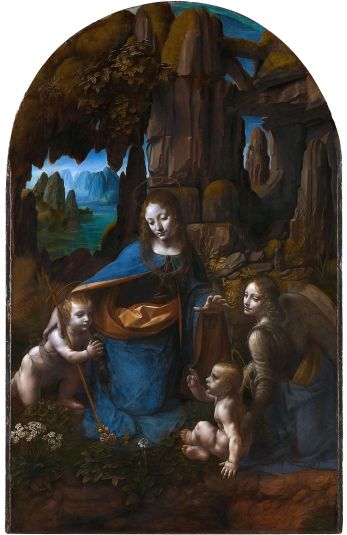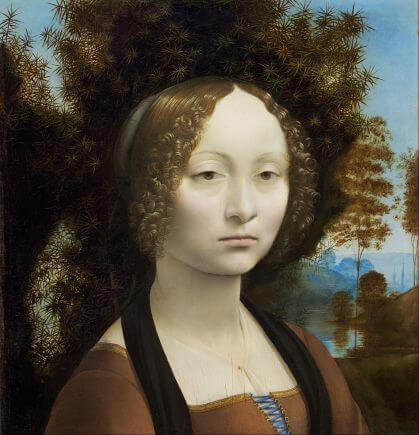|
Where? First floor, room 711 of the Denon wing in the Louvre
When? Between 1503 and 1517 Commissioned by? Francesco del Giocondo, the husband of Mona Lisa. What do you see? A half-body portrait of Lisa del Giocondo. She is sitting outside in a chair with a straight posture. Her curly hair hangs on her shoulders, and she has a transparent veil on her head (which may be a sign that she is pregnant). She is wearing a dress with a bit of lace and a scarf over the shoulders. The light skin of her contrasts nicely with the darker tones in the rest of the painting. Note that she has no eyebrows, something that was not uncommon in portraits from that time, though research has shown that the Mona Lisa may originally have had some faint eyebrows. Her hands are crossed and laying on an armrest. She looks at us with an ambiguous expression. Her eyes and her small mysterious smile have been intriguing to viewers all across the world. What is she thinking about and what is she looking at? The background shows a rocky landscape, and Leonardo da Vinci was the first to include such a background in a portrait painting. You can see almost snowy mountains, a winding road on the left and a bridge on the right. It seems that the landscape on the left and the right of Mona Lisa do not match up as the left side is lower than the right side. Backstory: Mona Lisa means ‘my lady Lisa. The word ‘mona’ is a short version of Madonna, which means ‘my lady’. This painting is also known in Italian as La Gioconda named after her last name. This painting was a very innovative one in the time that it was painted due to its composition and the painting technique used by Leonardo da Vinci. Da Vinci accepted the commission for this painting during a time in which he had little money. However, soon after he received some big commissions and it took him, therefore, many years to complete this painting. After Leonardo da Vinci started to work in France, this painting was acquired by King Francis I of France. So, Da Vinci never delivered this painting to its commissioner. The painting remained in France ever since and Napoleon Bonaparte put the painting in his bedroom. In 1804, the painting was moved to Louvre and people could now see the painting that Napoleon was sleeping with. The painting is nowadays displayed in a climate-controlled room and behind bullet-proof glass. Sfumato? One of the things that makes this painting so popular is the use of sfumato by Leonardo da Vinci. This is a technique that Da Vinci developed in which he blended colors on the canvas. Sfumato is derived from the Italian word ‘fumo’, which means smoky. When we translate sfumato to English, it means something like soft or blurry. The transitions from light to dark are barely visible on the canvas, and you cannot see the brushstrokes on the painting. The soft transition is in stark contrast to the impressionist paintings, where the brush strokes are very visible. For example, look at Wheat Field with Cypresses by Van Gogh. The use of the sfumato technique leads to more realistic paintings. Other good examples of the sfumato technique are Da Vinci’s paintings of the Virgin of the Rocks of which one version is in the Louvre and another one in the National Gallery of Art. The sfumato technique had a big influence on other artists, including Raphael, who adopted this technique for some of his portraits.
Who is Mona Lisa? Born as Lisa di Antonio Maria Gherardini in the Republic of Florence in 1479, Lisa married with Francesco di Bartolomeo di Zanobi del Giocondo in 1495. She was the third wife of Francesco, who was a merchant and later became a government official in Florence. It seems that their marriage was based on real love, which was not that common during that time, and together they got five children.
Francesco came from a family of art lovers and commissioned a painting of Lisa to celebrate the purchase of a new home. Mona Lisa lived a normal life and apart from this painting not much is known about her. Who is Leonardo da Vinci? Leonardo di ser Piero da Vinci (1452-1519) was born in Vinci in the Republic of Florence. He is considered to be the ultimate Renaissance man as he was not only an artist, but also an astronomer, a geologist, an inventor, a mathematician, a musician, and a writer. Together with Donatello, Michelangelo, and Raphael, he is considered to be one of the four leading artists from the Renaissance. He created a large variety of art, but he often did not finish his works. Among his surviving works are a few portraits including his Ginevra de’ Benci in the National Gallery of Art.
Fun fact: In August of 1911, the Mona Lisa was stolen from the Louvre. This theft was a big shock as the Louvre was heavily guarded and it was a big mystery how the painting got stolen. However, it was not a complete disaster as, in 1911, the Mona Lisa was not yet considered to be the best painting in the world yet. The robbery spurred a lot of attention for the painting in the media.
One of the popular theories from those days was that Picasso stole the painting. The police even questioned Picasso but found no evidence against him. In 1913, the painting was retrieved when an employee of the Louvre wanted to sell the painting for $100,000 to the Uffizi Museum in Florence. After this robbery, the Mona Lisa was suddenly one of the most special paintings in the world, and it has only grown in popularity since. Nowadays, about ten million people visit the Louvre each year, and most of them want to see this painting. Interested in a copy for yourself? Poster of canvas (Amazon links).
Written by Eelco Kappe
References:
1 Comment
Free Mind Publications
3/5/2021 04:01:21 pm
Here is an interesting lecture about the painting with new interesting insights https://www.youtube.com/watch?v=d2y8xQxWwfo&t=4s
Reply
Leave a Reply. |
Categories
All
|
- Home
- Blog
-
Museums
- Alte Pinakothek
- Art Institute of Chicago
- Baltimore Museum of Art
- Barber Institute of Fine Arts
- Bargello
- Barnes Foundation
- British Museum
- Church of Sant’Anastasia
- Cleveland Museum of Art
- Courtauld Institute of Art
- Detroit Institute of Arts
- Frans Hals Museum
- Galleria Borghese
- Gallerie dell'Accademia
- Getty Museum
- Guggenheim
- Hermitage Museum
- Kunsthistorisches Museum
- Kunstmuseum Basel
- Legion of Honor Museum
- Louvre
- Mauritshuis
- Metropolitan Museum of Art
- Musee d’Orsay
- Museum of Fine Arts in Boston
- Museum of Modern Art
- National Gallery in London
- National Gallery of Art
- National Museum in Poznań
- Norton Simon Museum
- Ny Carlsberg Glyptotek
- Palace of Versailles
- Palazzo Pitti
- Palazzo Vecchio
- Petit Palais
- Philadelphia Museum of Art
- Prado
- Pushkin Museum
- Ravenna Art Museum
- Rijksmuseum
- San Diego Museum of Art
- Santa Maria delle Grazie
- St. Peter's Basilica
- Städel Museum
- Statens Museum for Kunst
- Tate Britain
- Tate Modern
- Timken Museum of Art
- Uffizi
- Vatican Museums
- Wallace Collection
-
Artists
- Altdorfer
- Anguissola
- Berlin Painter
- Bosch
- Botticelli
- Boucher
- Bronzino
- Bruegel the Elder
- Brunelleschi
- Cabanel
- Caillebotte
- Canova
- Caravaggio
- Carpeaux
- Cezanne
- Cimabue
- David
- Degas
- Delacroix
- De Maria
- Donatello
- El Greco
- Fontana
- Fra Angelico
- Fragonard
- Gauguin
- Gentileschi
- Gericault
- Gonzalez-Torres
- Goya
- Hals
- Hogarth
- Hokusai
- Ingres
- Leonardo da Vinci
- Lippi, Filippo
- Longhi, Barbara
- Lorrain
- Makovsky
- Manet
- Massys
- Matisse
- Merian
- Michelangelo
- Mochi
- Modigliani
- Monet
- Panini
- Parmigianino
- Perugino
- Picasso
- Pisanello
- Raphael
- Rembrandt
- Renoir
- Reynolds
- Rivera
- Rodin
- Rubens
- Scultori
- Seurat
- Steen
- Tintoretto
- Titian
- Toulouse-Lautrec
- Turner
- Uccello
- Van der Weyden
- Van Dyck
- Van Eyck
- Van Gogh
- Van Hemessen
- Vasari
- Velazquez
- Vermeer
- Veronese
- Vigée Le Brun
-
Locations
- Books
- About Us




